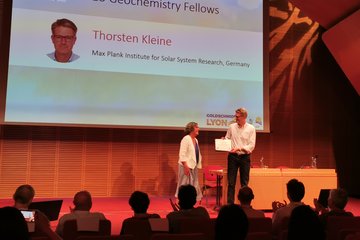Alle Typen
1.
Zeitschriftenartikel
Coronal condensation as the source of transition-region supersonic downflows above a sunspot. Astronomy and Astrophysics 659, S. A107 (2022)
2.
Zeitschriftenartikel
Doppler shifts of spectral lines formed in the solar transition region and corona. Astronomy and Astrophysics 661, S. A94 (2022)
3.
Zeitschriftenartikel
The SUMER Ly-α profile of quiescent prominences. Astronomy and Astrophysics 511, L4 (2010)
4.
Zeitschriftenartikel
Solar wind origins in coronal holes and in the quiet Sun. Advances in Space Research 45, S. 303 - 309 (2010)
5.
Zeitschriftenartikel
New views on the emission and structure of the solar transition region. New Astron. Rev. 54, S. 13 - 30 (2010)
6.
Zeitschriftenartikel
Signatures of transition region explosive events in hydrogen Ly beta profiles. Astronomy and Astrophysics 520, A37 (2010)
7.
Zeitschriftenartikel
Semiempirical Models of the Solar Atmosphere. III. Set of Non-Lte Models for Far-Ultraviolet/Extreme-Ultraviolet Irradiance Computation. Astrophysical Journal 707 (1), S. 482 - 502 (2009)
8.
Zeitschriftenartikel
Excitation of kink waves due to small-scale magnetic reconnection in the chromosphere? Astrophysical Journal 705, S. L217 - L222 (2009)
9.
Zeitschriftenartikel
Hydrogen Lyman-α and Lyman-β spectral radiance profiles in the quiet Sun. Astronomy and Astrophysics 504, S. 239 - 248 (2009)
10.
Zeitschriftenartikel
Solar transition region above sunspots. Astronomy and Astrophysics 505, S. 307 - 318 (2009)
11.
Zeitschriftenartikel
Upflows in funnel-like legs of coronal magnetic loops. Astrophysical Journal 704, S. 883 - 890 (2009)
12.
Zeitschriftenartikel
Hydrogen Ly α and Ly β Radiances and Profiles in Polar Coronal Holes. Astrophysical Journal 703 (2), S. L152 - L156 (2009)
13.
Zeitschriftenartikel
The redshifted network contrast of transition region emission. Astronomy and Astrophysics 491, S. L13 - L16 (2008)
14.
Zeitschriftenartikel
The Ly-α profile and center-to-limb variation of the quiet Sun. Astronomy and Astrophysics 492, S. L9 - L12 (2008)
15.
Zeitschriftenartikel
Radiance and Doppler shift distributions across the network of the quiet Sun. Astronomy and Astrophysics 489 (3), S. 1297 - 1306 (2008)
16.
Zeitschriftenartikel
Network oscillations at the boundary of an equatorial coronal hole. Astronomy and Astrophysics 488 (1), S. 331 - 337 (2008)
17.
Zeitschriftenartikel
The Emission Heights of Transition Region Lines in an Equatorial Coronal Hole and the Surrounding Quiet Sun. Chin. J. Astron. Astrophys. 8 (6), S. 732 - 742 (2008)
18.
Zeitschriftenartikel
Long-period oscillations in solar coronal bright points. Astronomy and Astrophysics 489 (2), S. 741 - 745 (2008)
19.
Konferenzbeitrag
Upward and downward propagation of transverse waves due to small-scale magnetic reconnection in the chromosphere. In: Twelfth International Solar Wind Conference, S. 32 - 35 (Hg. Maksimovic, M.; Issautier, K.; Meyer-Vernet, N.; Moncuquet, M.; Pantellini, F.). American Institute of Physics (2010)
20.
Konferenzbeitrag
Upflows in the upper transition region of the quiet Sun. In: Twelfth International Solar Wind Conference, S. 36 - 39 (Hg. Maksimovic, M.; Issautier, K.; Meyer-Vernet, N.; Moncuquet, M.; Pantellini, F.). American Institute of Physics (2010)











